Creative Thinking in the Architecture Design Studio: Bibliometric Analysis and Literature Review
Abstract
1. Introduction
2. Materials and Methods
2.1. The Aim and Scope of the Study
- RQ1. How can creativity in the design process be evaluated in students’ work?
- RQ2. What are some effective educational tools in the design studio to support the creativity of design concepts?
- RQ3. What educational practices are found in design studios to enhance creativity?
2.2. Framework for the Study
2.3. Study Selection: Phase 1
- document types: journal articles and proceedings articles excluding review articles;
- use of language: English;
- publication year: from 1982 to 2022.
2.4. Bibliometric Approach: Phase 2
- number of publications in a year;
- total citations;
- most productive authors and countries;
- co-occurrence network of author keywords.
3. Results: Bibliometric Analysis
- Citation analysis classifies the relationships between the most significant publications in the field of creativity in the design studio;
- Co-citation analysis reveals the intellectual structure through publications, assuming publications that are cited together frequently are similar thematically;
- Bibliographic coupling exposes periodical or current development of topics through the relationships between cited publications;
- Co-word analysis discovers existing and future relationships between topics in the research area of creativity in the design studio;
- Co-authorship observes the research network among authors and the equivalent impacts on the development of creativity in the design studio.
3.1. Performance Analysis: Phase 3 (1)
3.1.1. Publication Years of Relevant Citations
3.1.2. Most Cited Publications
3.1.3. Most Prolific Authors
3.2. Science Mapping: Phase 3 (2)
3.2.1. Co-Authorship Analysis of Authors
- (1)
- Authors
- (2)
- Countries
- Turkey and the United States had the greatest total link strength in relation to the international collaboration of authors;
- China, Spain, India, and South Korea had a high number of publications, but their international collaboration strength was relatively low.
- (3)
- Organization
3.2.2. Co-Occurrence—Keywords Plus
- Yellow cluster: Groups keywords such as creativity, design thinking, and experience;
- Pink cluster: Groups keywords such as design, tool, and sustainability;
- Brown cluster: Groups keywords such as education, knowledge, and challenges.
3.3. Intervention Methods of the Studies
3.3.1. Creativity in the Design Studio
- (1)
- Creativity criteria
- Guilford emphasized divergent thinking and that creativity is closely related to reconstructing problems and defined fluency, flexibility, and originality [5];
- Goldschmidt argued that convergent thinking also plays a role in creativity, and design literature, which views design as a priori creative activity, mostly accepts this view [16];
- Doston argued that interest in design thinking was sparked in organizations that had difficulty dealing with complex problem situations, which could be particularly useful in the context of abductive reasoning in how design practices handled themes and frames [12];
- Taylor proposed five typologies of creativity: expressive, productive, inventive, innovative, and emergent [52];
- Jackson and Shaw reported specific topics of definition, including creativity, innovation, transfer, and application of ideas [53];
- Using qualitative analysis, Kleiman observed five categories of creative experience: constraint-oriented, process-oriented, product-oriented, transformation-oriented, and implementation-oriented [54];
- Cropley defined engineers as problem solvers, explained that the core activity of engineering is design, and suggested that creativity is inherent in the design process [55].
- (2)
- Creativity evaluation
- Casakin and Kreitler emphasized the relationship between the evaluation of creativity in design problem solving and the level of expertise of evaluators [58];
- Hargrove and Nietfeld noted that evaluation played an important role in tracking students’ conceptual understanding of the metacognitive process [59];
- Acikgoz evaluated the quality of learning achieved during the design team collaboration based on a rubric that included defining problems, idea generation, linking and integrating ideas, and adapting to the task at hand. He has shown that structured architectural processes significantly affect the overall consistency between design thinking, idea generation, and finding solutions [60];
- Choi and Kim enhanced novelty and familiarity measurement by using “third elements” that address ambiguous aspects such as clarity, communication, and observation to capture the behavioral aspects related to creative activities. The development of this triangular approach is worth considering in a very social and dynamic space [61];
- Grover et al. evaluated the support provided by typology in three key stages of the design process. Exploring the framing stage of a design project has shown that searching for relevant functions and identifying metaphorical typologies based on cultural, contextual, or empirical phenomena is challenging for most students [62].
3.3.2. Idea Generation and Development
- (1)
- Reasoning patterns
- Dorst described abduction as a basic inference pattern for design strategies that define creative thinking. He studied the core of design thinking for idea generation, defined design-derived reasoning patterns, and emphasized abduction as the fundamental reasoning pattern for creative thinking [12];
- Casakin and van Timmeren revealed that analogical reasoning supports architectural education by employing visual and verbal analogies in the early stages of the design process [65];
- Schön argued that metaphor can help one reflect on the nature of a situation when solving unusual design problems. Without metaphor, it would be difficult to obtain solutions [27];
- Orthony emphasized that metaphor allows us to understand unknown situations in relation to familiar situations [66].
- (2)
- Representation tools
- Choi and Kim described how stimuli can generate thought extensions. Their work focused on the level of abstraction provided during brainstorming and troubleshooting, and the authors suggest that this can be particularly effective in digital contexts [73];
- Juhani emphasized that drawing refers to the essential meaning of revealing and embodying inner thoughts and emotions as much as recording the external world [74];
- Clear described that architectural drawings are traditionally considered to have two main functions: communicating practical information about design and constructing architectural projects, or communicating aesthetic information about building materials or stylistic aspirations [75];
- Park revealed that drawings represent a good medium for design and communication, and text could stimulate students’ creativity as a thinking transition in architectural studios [29].
3.3.3. Pedagogy in the Design Studio
- (1)
- Design studio set-up
- Goldschmidt and Tatsa analyzed student ideas generated during the development of a design studio project with additional ideas organized by fellow students and instructors. Their approach led to deep insights into how ideas are structured along the design process in terms of quality as well as quantity [40];
- Casakin and Kreitler compared the way students and teachers explored the design creativity process and outcomes. They found that while students focused on operational aspects, teachers paid more attention to innovative aspects of student processes and outcomes. They concluded that design studio intervention programs could consider these differences to facilitate the acquisition of design procedures and provide deeper insights into how students perceive design creativity compared to teachers [58];
- Asefi and Imani considered more broadly the “mode transitions” required to accommodate different types of thinking employed in different stages of the design process by using comparative studies of student outcomes. They advocated an active strategic education model and assigned various tools and methods for use in design studio work [76];
- Kowaltowski et al., from the perspective of an instructor, reviewed the creativity method and its use in a design studio. They interviewed 28 design instructors on how to apply it to design studios, reporting that the method is typically applied in an unstructured manner and that a more structured approach would help [49];
- Grover et al., used the historical theory of typology as a structured framework for the knowledge search contained in architectural building precedents to guide students through various stages of the design process. The design phase included frame definition, conceptual design, and detailed project development [62];
- Suh and Cho explored the relationship between an individual’s cognitive style and creative performance by structuring the design process according to the different design stages. Their study found that intuitive students were more creative in the early stages, whereas adaptive and more analytical students improved their creativity at the end of the process [77];
- Kavousi et al., proposed a conceptual model that focuses on the impact of metacognitive processing in design education on student design thinking and making. Their research demonstrated how super-cognitive components interact and how they support training programs to improve the design process and creative outcomes generated [78];
- Avsec revealed that design thinking is closely related to self-directed learning and emphasized that creative design thinking can provide metacognitive insights that include interpersonal skills, creativity, and digital skills that are strongly explained by design thinking variables [79].
- (2)
- Enhancing creativity
- Alterio and McDrury revealed that reflection on experience creates meaningful learning to improve creativity, interprets learning as behavior, and evaluates the results of these behaviors through self-reflection learning. This learning method shows that reflective practice trains students’ creativity during studio projects [80];
- Hargrove and Nietfeld explored the effectiveness of creativity education in the form of associated thinking strategies. The pedagogical approach aimed at supporting creative problem solving consisted of integrating activities related to creative thinking strategies to encourage super-cognitive development. Creative thinking reflects the ability to be trained and developed over time [59];
- Bhattacharya et al., argued that active exposure to unusual experiences and/or situations can have useful creativity-enhancing applications in design studios. Their pedagogical approach was based on the idea that a conceptual mix of virtual scenarios can be used to enhance and train divergent thinking while dealing with a variety of unfamiliar and unexpected design situations [81].
- (3)
- Problem-solving
- Kruger and Cross described that designers using problem-driven design strategies manage to produce the best results in terms of a balance between overall solution quality and creativity [82];
- Wrigley verified that design thinking creates a highly reflective creative process that allows students to review and critically think about their design process to create a deeper understanding of the evolution of design thinking as a problem-solving activity [83];
- Lee et al., revealed that the design process sometimes begins with solutions that are not problems through the empirical study of engineering designers with experience in successfully searching for problems that fit new technology solutions [84].
3.4. Overall Review
4. Discussion
5. Conclusions
Author Contributions
Funding
Data Availability Statement
Conflicts of Interest
References
- Runco, M. Commentary: Divergent Thinking Is Not Synonymous with Creativity. Psychol. Aesthet. Creat. Arts 2008, 2, 93–96. [Google Scholar] [CrossRef]
- Gero, J.S. Shape emergence and symbolic reasoning using maximal lines. 1992; unpublished work. [Google Scholar]
- Visser, W. Dynamic aspects of design cognition: Elements for a cognitive model of design. In Theme 3A-Databases, Knowledge Bases and Cognitive Systems; INRIA: Rocquencourt, France, 2004. [Google Scholar]
- Dorst, K.; Cross, N. Creativity in the design process: Co-evolution of problem-solution. Des. Stud. 2001, 22, 425–437. [Google Scholar] [CrossRef]
- Guilford, J.P. Creativity. Am. Psychol. 1950, 5, 444–454. [Google Scholar] [CrossRef] [PubMed]
- Perttula, M.K. Idea Generation in Engineering Design: Application of a Memory Search Perspective and Some Experimental Studies; Helsinki University of Technology: Espoo, Finland, 2006. [Google Scholar]
- Cross, N. Designerly ways of knowing. Des. Stud. 1982, 3, 221–227. [Google Scholar] [CrossRef]
- Peters, R.S. Education as Initiation; Routledge & Kegan Paul: London, UK, 1965. [Google Scholar]
- Teal, R. Developing a (non-linear) practice of design thinking. J. Art Des. Educ. 2010, 29, 295–297. [Google Scholar] [CrossRef]
- Dorst, K. The Nature of Design Thinking. 2010. Available online: https://opus.lib.uts.edu.au/bitstream/10453/16590/1/2010000367OK.pdf (accessed on 2 January 2022).
- Park, E.J.; Kim, M.J. Visual Communication for Students’ Creative Thinking in the Design Studio: Translating Filmic Spaces into Spatial Design. Buildings 2021, 11, 91. [Google Scholar] [CrossRef]
- Dorst, K. The core of ‘design thinking’ and its application. Des. Stud. 2011, 32, 521–532. [Google Scholar] [CrossRef]
- Choi, H.H.; Kim, M.J. The effects of analogical and metaphorical reasoning on design thinking. Think. Ski. Creat. 2017, 23, 29–41. [Google Scholar] [CrossRef]
- Baker, M.; Rudd, R. Relationship between critical and creative thinking. J. South. Agric. Educ. Res. 2001, 52, 173–188. [Google Scholar]
- Combs, L.B.; Cennamo, K.S.; Newbill, P.L. Developing Critical and Creative Thinkers: Toward a Conceptual Model of Creative and Critical Thinking Processes. Educ. Technol. 2009, 49, 3–14. [Google Scholar]
- Goldschmidt, G. Linkographic evidence for concurrent divergent and convergent thinking in creative design. Creat. Res. J. 2016, 28, 115–122. [Google Scholar] [CrossRef]
- Ustaomeroglu, A.; Aydintan, E.; Erbay, M.; Kucuk, P.; Sadiklar, Z. The Impact of Basic Design Studio Courses on Interior Design: KTU Model. Procedia Soc. Behav. Sci. 2015, 197, 173–183. [Google Scholar] [CrossRef][Green Version]
- Kelley, T.; Kelley, D. Reclaim your creative confidence. Harv. Bus. Rev. 2012, 90, 115–118. [Google Scholar] [PubMed]
- Royalty, A.; Oishi, L.N.; Roth, B. Acting with creative confidence: Developing a creative agency assessment tool. In Design Thinking Research; Springer: Berlin/Heidelberg, Germany, 2014; pp. 79–96. [Google Scholar]
- Varma, A.; Jafri, M.S. COVID-19 responsive teaching of undergraduate architecture programs in India: Learnings for post-pandemic education. Archnet IJAR Int. J. Archit. Res. 2020, 15, 189–202. [Google Scholar] [CrossRef]
- Zacks, J.M.; Mires, J.; Tversky, B.; Hazeltine, E. Mental spatial transformations of objects and perspective. Spat. Cogn. Comput. 2000, 2, 315–332. [Google Scholar] [CrossRef]
- Ho, C.-H. Spatial Cognition in Design; Georgia Institute of Technology: Atlanta, GA, USA, 2006. [Google Scholar]
- Allen, A.D. Complex spatial skills: The link between visualization and creativity. Creat. Res. J. 2010, 22, 241–249. [Google Scholar] [CrossRef]
- Cho, J.Y. An investigation of design studio performance in relation to creativity, spatial ability, and visual cognitive style. Think. Ski. Creat. 2017, 23, 67–78. [Google Scholar] [CrossRef]
- Nazidizaji, S.; Tome, A.; Regateiro, F.; Ghalati, A.K. Narrative ways of architecture education: A case study. Procedia Soc. Behav. Sci. 2015, 197, 1640–1646. [Google Scholar] [CrossRef][Green Version]
- Schön, D.A. The architectural studio as an exemplar of education for reflection-in-action. J. Archit. Educ. 1984, 38, 2–9. [Google Scholar] [CrossRef]
- Schön, D.A. Educating the Reflective Practitioner: Toward a New Design for Teaching and Learning in the Professions; Jossey-Bass: Hoboken, NJ, USA, 1987. [Google Scholar]
- Schön, D.A. Toward a marriage of artistry & applied science in the architectural design studio. J. Archit. Educ. 1988, 41, 4–10. [Google Scholar]
- Park, E.J.; Kim, D.-H.; Kim, M.J. Architecture and the imaginary: Text stimulus to improve students’ creativity with nonlinear design process. Archnet IJAR Int. J. Archit. Res. 2022. ahead-of-print. [Google Scholar] [CrossRef]
- Salama, A.M. A theory for integrating knowledge in architectural design education. Archnet IJAR Int. J. Archit. Res. 2008, 2, 100–128. [Google Scholar]
- Salama, A.M. Delivering theory courses in architecture: Inquiry based, active, and experiential learning integrated. Archnet IJAR Int. J. Archit. Res. 2010, 4, 278–295. [Google Scholar]
- Salama, A.M. Knowledge and design: People-environment research for responsive pedagogy and practice. Procedia Soc. Behav. Sci. 2012, 49, 8–27. [Google Scholar] [CrossRef]
- Wang, T. A New Paradigm for Design Studio Education. Int. J. Art Des. Educ. 2010, 29, 173–183. [Google Scholar] [CrossRef]
- Orbey, B.; Sarıoğlu Erdoğdu, G.P. Design process re-visited in the first year design studio: Between intuition and reasoning. Int. J. Technol. Des. Educ. 2020, 31, 771–795. [Google Scholar] [CrossRef]
- Choi, H.; Cho, M.E.; Kim, M.J. A Critical Review of Research on Design Education Focusing on Creativity in Architectural Design. Arch. Des. Res. 2013, 26, 119–138. [Google Scholar]
- Carney, M.; Gedajlovic, E.R.; Heugens, P.P.; Van Essen, M.; Van Oosterhout, J. Business group affiliation, performance, context, and strategy: A meta-analysis. Acad. Manag. J. 2011, 54, 437–460. [Google Scholar] [CrossRef]
- Donthu, N.; Kumar, S.; Mukherjee, D.; Pandey, N.; Lim, W.M. How to conduct a bibliometric analysis: An overview and guidelines. J. Bus. Res. 2021, 133, 285–296. [Google Scholar] [CrossRef]
- Palmatier, R.W.; Houston, M.B.; Hulland, J. Review articles: Purpose, process, and structure. J. Acad. Mark. Sci. 2018, 46, 1–5. [Google Scholar] [CrossRef]
- Tranfield, D.; Denyer, D.; Smart, P. Towards a methodology for developing evidence-informed management knowledge by means of systematic review. Br. J. Manag. 2003, 14, 207–222. [Google Scholar] [CrossRef]
- Goldschmidt, G.; Tatsa, D. How good are good ideas? Correlates of design creativity. Des. Stud. 2005, 26, 593–611. [Google Scholar] [CrossRef]
- Goldschmidt, G.; Sever, A.L. Inspiring design ideas with texts. Des. Stud. 2011, 32, 139–155. [Google Scholar] [CrossRef]
- Ozkan, O.; Dogan, F. Cognitive strategies of analogical reasoning in design: Differences between expert and novice designers. Des. Stud. 2013, 34, 161–192. [Google Scholar] [CrossRef]
- Rahimian, F.P.; Ibrahim, R. Impacts of VR 3D sketching on novice designers’ spatial cognition in collaborative conceptual architectural design. Des. Stud. 2011, 32, 255–291. [Google Scholar] [CrossRef]
- Kokotovich, V. Problem analysis and thinking tools: An empirical study of non-hierarchical mind mapping. Des. Stud. 2008, 29, 49–69. [Google Scholar] [CrossRef]
- Ibrahim, R.; Rahimian, F.P. Comparison of CAD and manual sketching tools for teaching architectural design. Autom. Constr. 2010, 19, 978–987. [Google Scholar] [CrossRef]
- Srinivasan, S.; Bettella, F.; Mattingsdal, M.; Wang, Y.P.; Witoelar, A.; Schork, A.J.; Thompson, W.K.; Zuber, V.; Winsvold, B.S.; Zwart, J.A.; et al. Genetic Markers of Human Evolution Are Enriched in Schizophrenia. Biol. Psychiatry 2016, 80, 284–292. [Google Scholar] [CrossRef]
- Demirkan, H.; Afacan, Y. Assessing creativity in design education: Analysis of creativity factors in the first-year design studio. Des. Stud. 2012, 33, 262–278. [Google Scholar] [CrossRef]
- Cai, H.; Do, E.Y.L.; Zimring, C.M. Extended linkography and distance graph in design evaluation: An empirical study of the dual effects of inspiration sources in creative design. Des. Stud. 2010, 31, 146–168. [Google Scholar] [CrossRef]
- Kowaltowski, D.; Bianchi, G.; de Paiva, V.T. Methods that may stimulate creativity and their use in architectural design education. Int. J. Technol. Des. Educ. 2010, 20, 453–476. [Google Scholar] [CrossRef]
- Sternberg, R.J. Handbook of Creativity; Cambridge University Press: Cambridge, UK, 1999. [Google Scholar]
- Kampylis, P.G.; Valtanen, J. Redefining creativity—Analyzing definitions, collocations, and consequences. J. Creat. Behav. 2010, 44, 191–214. [Google Scholar] [CrossRef]
- Taylor, I.A. The nature of the creative process. Creativity 1959, 51–82. Available online: https://files.eric.ed.gov/fulltext/ED043898.pdf (accessed on 18 May 2022).
- Jackson, N.; Shaw, M. Subject Perspectives on Creativity: A Preliminary Synthesis; An Imaginative Curriculum Study for the Higher Education Academy: York, UK, 2005; Volume 4, p. 2008. [Google Scholar]
- Kleiman, P. Towards transformation: Conceptions of creativity in higher education. Innov. Educ. Teach. Int. 2008, 45, 209–217. [Google Scholar] [CrossRef]
- Cropley, D.H. Creativity in Engineering: Novel Solutions to Complex Problems; Academic Press: Cambridge, MA, USA, 2015. [Google Scholar]
- Jeffrey, B.; Craft, A. Teaching Creatively and Teaching for Creativity: Distinctions and Relationships. Educ. Stud. 2004, 30, 77–87. [Google Scholar] [CrossRef]
- Loveless, A.; Burton, J.; Turvey, K. Developing conceptual frameworks for creativity, ICT and teacher education. Think. Ski. Creat. 2006, 1, 3–13. [Google Scholar] [CrossRef]
- Casakin, H.; Kreitler, S. Correspondences and divergences between teachers and students in the evaluation of design creativity in the design studio. Environ. Plan. B Plan. Des. 2008, 35, 666–678. [Google Scholar] [CrossRef]
- Hargrove, R.A.; Nietfeld, J.L. The impact of metacognitive instruction on creative problem solving. J. Exp. Educ. 2015, 83, 291–318. [Google Scholar] [CrossRef]
- Açikgöz, E.K. Uncovering Creativity: Structuring experience in architectural design studio. Open House Int. 2015, 40, 12–21. [Google Scholar] [CrossRef]
- Choi, H.H.; Kim, M.J. The Potential of Reasoning Methods as a Teaching Strategy Supporting Students’creative Thinking in Architectural Design. Archnet IJAR Int. J. Archit. Res. 2016, 10, 6. [Google Scholar] [CrossRef]
- Grover, R.; Emmitt, S.; Copping, A. The typological learning framework: The application of structured precedent design knowledge in the architectural design studio. Int. J. Technol. Des. Educ. 2018, 28, 1019–1038. [Google Scholar] [CrossRef]
- Holyoak, K.J.; Thagard, P. The analogical mind. Am. Psychol. 1997, 52, 35. [Google Scholar] [CrossRef]
- Hofstadter, D. Epilogue: Analogy as the Core of Cognition. In The Analogical Mind, Perspectives from Cognitive Science; Gentner, D., Holyoak, K.J., Kokinov, B.K., Eds.; MIT Press: Cambridge, MA, USA, 2001. [Google Scholar]
- Casakin, H.; van Timmeren, A. Analogies as creative inspiration sources in the design studio: The teamwork. In Proceedings of the 4th Annual International Conferece on Architecture, Athens, Greece, 6–9 July 2014. [Google Scholar]
- Ortony, A. Metaphor and Thought; Cambridge University Press: Cambridge, UK, 1991. [Google Scholar]
- Schön, D.A.; Wiggins, G. Kinds of seeing in designing. Creat. Innov. Manag. 1992, 1, 68–74. [Google Scholar] [CrossRef]
- Epstein, R.; Schmidt, S.M.; Warfel, R. Measuring and training creativity competencies: Validation of a new test. Creat. Res. J. 2008, 20, 7–12. [Google Scholar] [CrossRef]
- Epstein, R.; Phan, V. Which competencies are most important for creative expression? Creat. Res. J. 2012, 24, 278–282. [Google Scholar] [CrossRef]
- Clark, R.M.; Stabryla, L.M.; Gilbertson, L.M. Sustainability coursework: Student perspectives and reflections on design thinking. Int. J. Sustain. High. Educ. 2020, 21, 593–611. [Google Scholar] [CrossRef]
- De Bono, E. Serious creativity. J. Qual. Particip. 1995, 18, 12. [Google Scholar]
- De Bono, E. Six Thinking Hats: The Multi-Million Bestselling Guide to Running Better Meetings and Making Faster Decisions; Penguin: London, UK, 2017. [Google Scholar]
- Choi, H.H.; Kim, M.J. Using the digital context to overcome design fixation: A strategy to expand students’design thinking. Archnet IJAR Int. J. Archit. Res. 2018, 12, 228–240. [Google Scholar] [CrossRef]
- Juhani, P. The Thinking Hand. Existential and Embodied Wisdom in Architecture; Wiley: Hoboken, NJ, USA, 2009. [Google Scholar]
- Clear, N. Drawing Drawings: Towards a Narrative Architecture. AIS Archit. Image Stud. 2020, 1, 6–8. [Google Scholar]
- Asefi, M.; Imani, E. Effects of active strategic teaching model (ASTM) in creative and critical thinking skills of architecture students. Archnet IJAR Int. J. Archit. Res. 2018, 12, 209. [Google Scholar] [CrossRef]
- Suh, J.; Cho, J.Y. Analyzing individual differences in creative performance: A case study on the combinational ideation method in the interior design process. J. Inter. Des. 2018, 43, 9–23. [Google Scholar] [CrossRef]
- Kavousi, S.; Miller, P.A.; Alexander, P.A. Modeling metacognition in design thinking and design making. Int. J. Technol. Des. Educ. 2020, 30, 709–735. [Google Scholar] [CrossRef]
- Avsec, S.; Jagiełło-Kowalczyk, M. Investigating possibilities of developing self-directed learning in architecture students using design thinking. Sustainability 2021, 13, 4369. [Google Scholar] [CrossRef]
- Alterio, M.; McDrury, J. Learning through Storytelling in Higher Education: Using Reflection and Experience to Improve Learning; Routledge: Abingdon-on-Thames, UK, 2003. [Google Scholar]
- Hakak, A.M.; Bhattacharya, J.; Biloria, N.; Ahmadi Venhari, A. The Proto-Fuse project: Methods to boost creativity for architects. Int. J. Des. Creat. Innov. 2016, 4, 206–221. [Google Scholar]
- Kruger, C.; Cross, N. Solution driven versus problem driven design: Strategies and outcomes. Des. Stud. 2006, 27, 527–548. [Google Scholar] [CrossRef]
- Wrigley, C.; Straker, K. Design thinking pedagogy: The educational design ladder. Innov. Educ. Teach. Int. 2017, 54, 374–385. [Google Scholar] [CrossRef]
- Lee, J.W.; Daly, S.R.; Huang-Saad, A.; Rodriguez, G.; Seifert, C.M. Cognitive strategies in solution mapping: How engineering designers identify problems for technological solutions. Des. Stud. 2020, 71, 100967. [Google Scholar] [CrossRef]
- Potur, A.A.; Barkul, Ö. Creative thinking in architectural design education. In Proceedings of the 1st International CIB Endorsed METU Postgraduate Conference Built Environment & Information Technologies, Ankara, Turkey, 17–18 March 2006; pp. 113–125. [Google Scholar]
- Nathan, M.J.; Sawyer, R.K. Foundations of the learning sciences. In the Cambridge Handbook of the Learning Sciences; Cambridge University Press: Cambridge, UK, 2014; pp. 21–43. [Google Scholar]

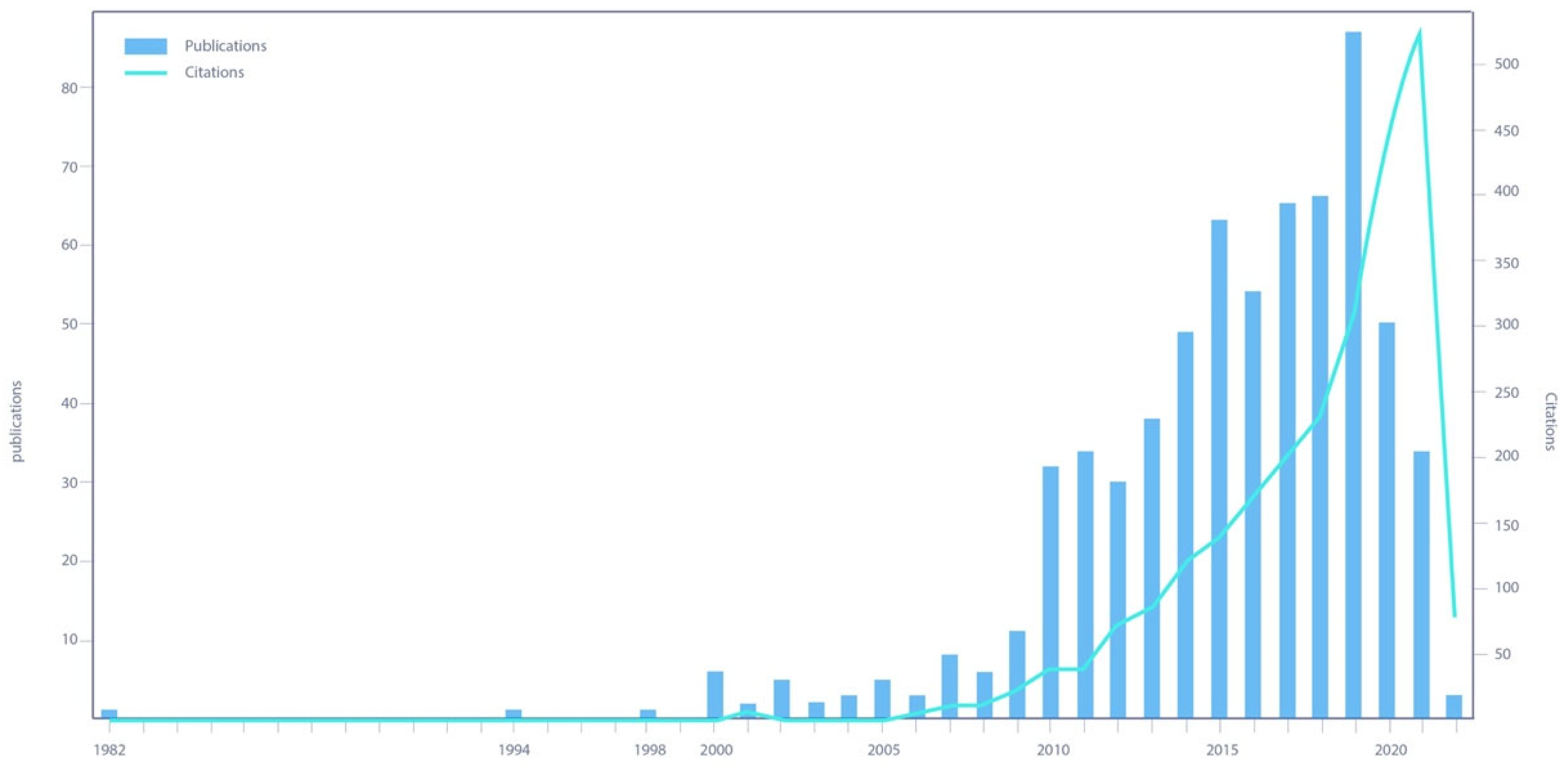
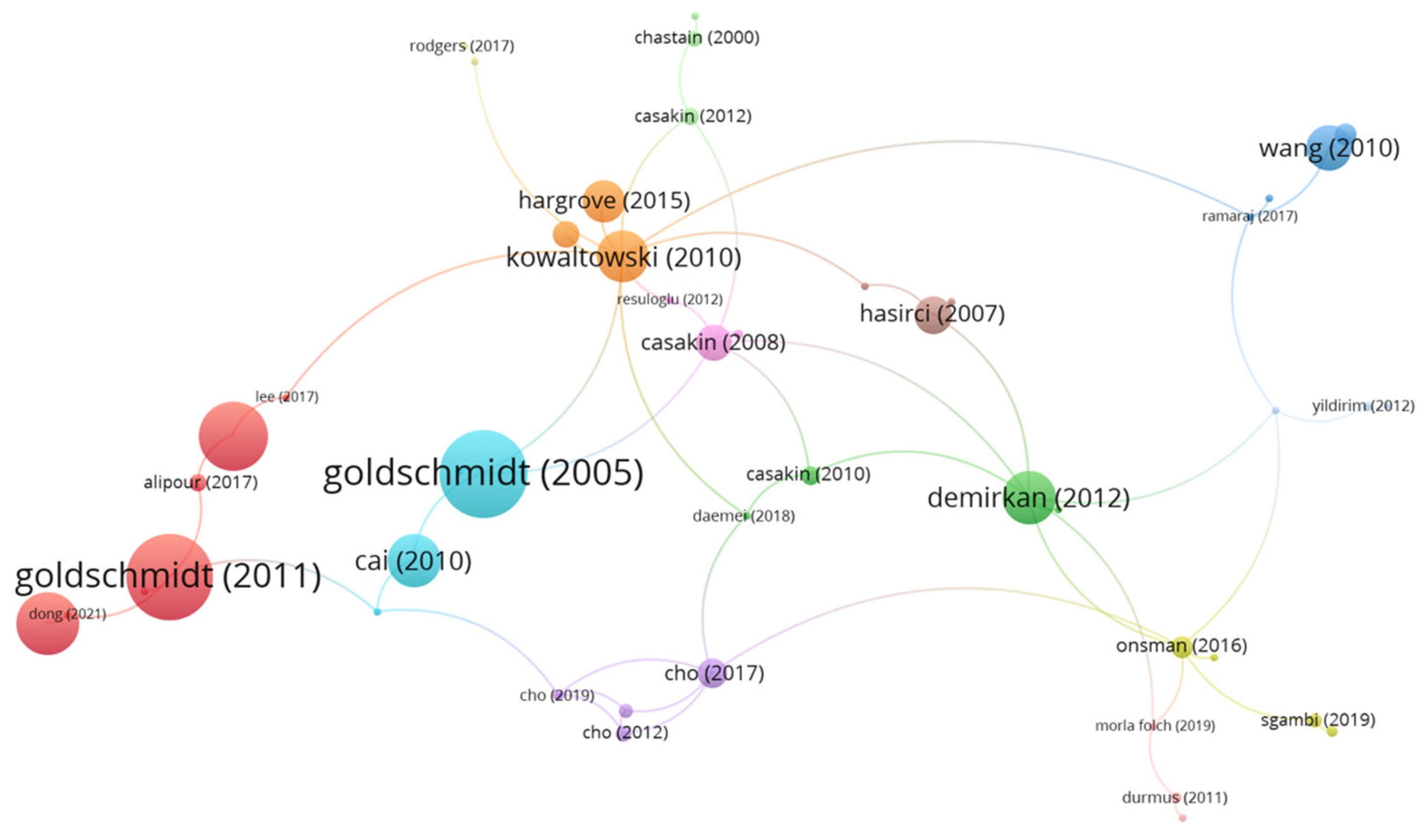
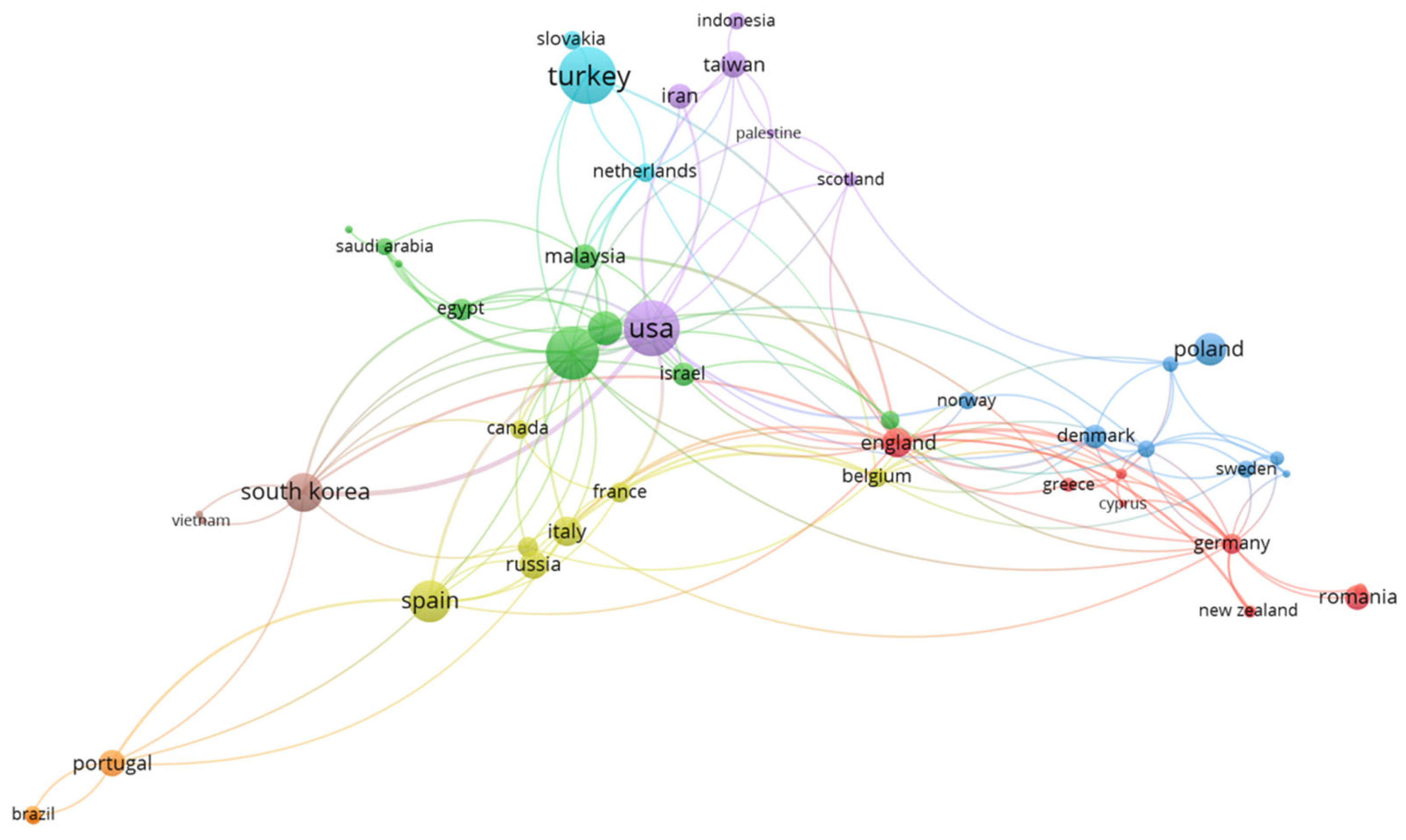

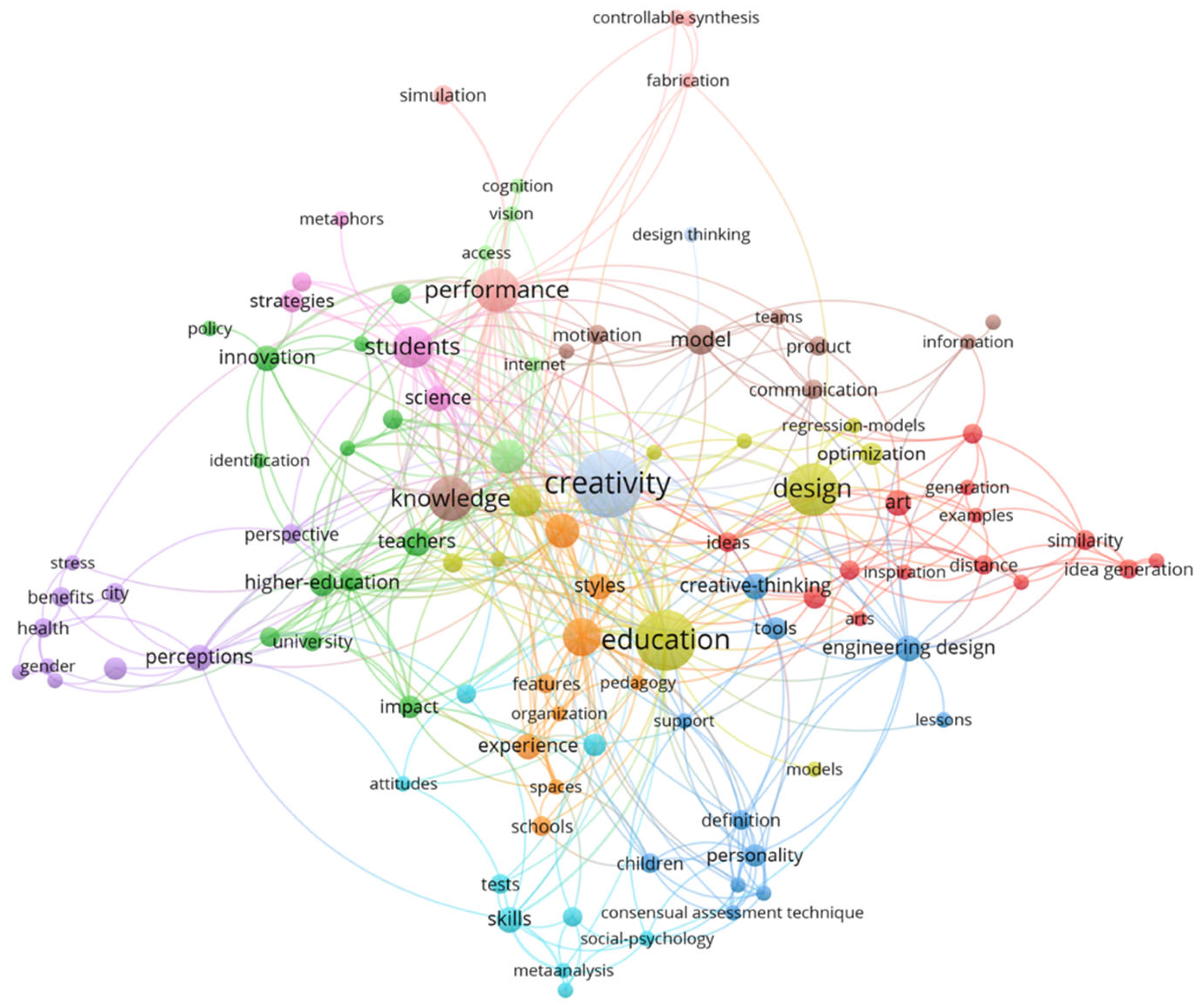
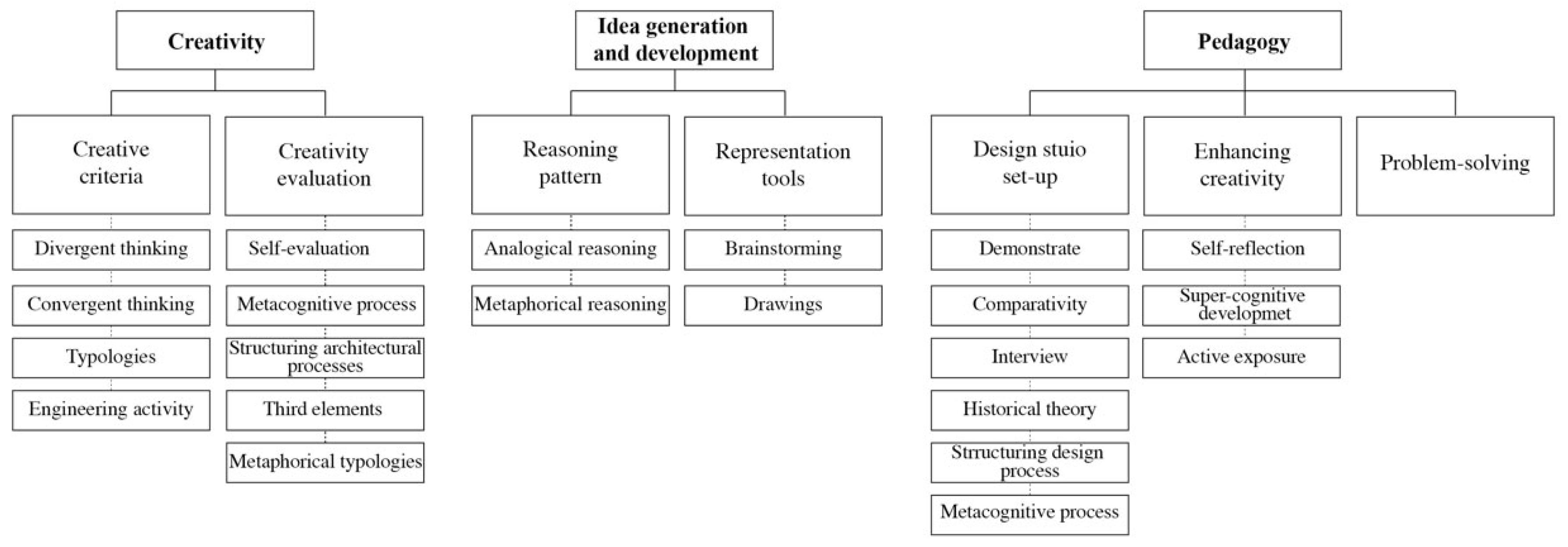
| Phase 1: | 2.3. Study selection | (1) Selection of databases with bibliometric data: The WoS | ||
| (2) Selection of software tools for analysis: VOSviewer | ||||
| (3) Selection of query wording and Boolean operators: (“creativity” or “creative thinking”) and (“design studio” or “education”) and (“architecture” or “urban design” or “built environment”) | ⇨ | n = 709 | ||
| (4) Selection of timespan: 1982–2022 | ⇨ | n = 708 | ||
| (5) Selection of document types: Journal articles and proceedings articles, excluding review articles | ⇨ | n = 685 | ||
| (6) Selection of language: English | ⇨ | n = 661 | ||
| (7) Screening | ⇨ | n = 658 | ||
| Phase 2: Bibliometric approach | 2.4. Bibliometric approach | (1) Descriptive bibliometric analysis of WoS research: Number of publication year | ||
| (2) Descriptive bibliometric analysis of WoS research: Total citations | ||||
| (3) Descriptive bibliometric analysis of WoS research: The most productive authors and countries | ||||
| (4) Descriptive bibliometric analysis of WoS research: Co-occurrence network of author keywords | ||||
| Phase 3: Bibliometric Analysis | 3.1. Performance analysis | 3.1.1. Converting data from WoS to appropriate format for bibliometric analysis: Publication years of relevant citations | ||
| 3.1.2. Most cited publications in WoS search result | ||||
| 3.1.3. Most prolific authors in WoS database | ||||
| 3.2. Science mapping | 3.2.1. Co-authorship analysis of authors: Mapping the scientific collaboration of authors, countries, and organizations | |||
| 3.2.2. Co-occurrence—Keywords in WoS: Most frequently used words, author keywords, co-occurrence, network of authors’ keywords | ⇨ | 105 keywords out of 502 | ||
| 3.3. Intervention methods of the studies | 3.3.1. Creativity in design studio: Creativity criteria Creativity evaluation | ⇨ | n = 36 | |
| 3.3.2. Idea generation and development: Reasoning patterns Representation tools | ||||
| 3.3.3. Pedagogy in design studio: Design studio set-up Enhancing creativity | ||||
| 3.4. Overall review | ||||
| Phase 4: | Discussion | |||
| Phase 5: | Conclusions and directions for future research | |||
| No. | Author(s) | Year Published | Paper Title | Journal | Discipline | Citation Count |
|---|---|---|---|---|---|---|
| 1 | Goldschmidt and Tatsa [40] | 2005 | How good are good ideas? Correlates of design creativity | Design Studies | Engineering | 93 |
| 2 | Goldschmidt and Sever [41] | 2011 | Inspiring design ideas with texts | Design Studies | Engineering | 89 |
| 3 | Ozkan and Dogan [42] | 2013 | Cognitive strategies of analogical reasoning in design: Differences between expert and novice designers | Design Studies | Engineering | 66 |
| 4 | Rahimian and Ibrahim [43] | 2011 | Impacts of VR 3D sketching on novice designers’ spatial cognition in collaborative conceptual architectural design | Design Studies | Engineering | 58 |
| 5 | Kokotovich [44] | 2008 | Problem analysis and thinking tools: an empirical study of non-hierarchical mind mapping | Design Studies | Engineering | 58 |
| 6 | Ibrahim and Rahimian [45] | 2010 | Comparison of CAD and manual sketching tools for teaching architectural design | Automation in Construction | Construction and Building Technology Engineering | 57 |
| 7 | Srinivasan et al. [46] | 2016 | Genetic markers of human evolution are enriched in schizophrenia | Biological Psychiatry | Neurosciences and Neurology Psychiatry | 50 |
| 8 | Demirkan and Afacan [47] | 2012 | Assessing creativity in design education: Analysis of creativity factors in the first-year design studio | Design Studies | Engineering | 46 |
| 9 | Cai et al. [48] | 2010 | Extended linkography and distance graph in design evaluation: An empirical study of the dual effects of inspiration sources in creative design | Design Studies | Engineering | 46 |
| 10 | Kowaltowski et al. [49] | 2010 | Methods that may stimulate creativity and their use in architectural design education | International Journal of Technology and Design Education Psychology | Education and Educational Research Engineering | 45 |
| Author | Institution | Country | Documents | Citations | |
|---|---|---|---|---|---|
| 1 | Kim, D.S. | Kumoh National University Technology | South Korea | 7 | 41 |
| 2 | Kim, M.H. | Kyung Hee University | South Korea | 7 | 25 |
| 3 | Casakin, H. | Ariel University | Israel | 6 | 53 |
| 4 | Hua, C.H. | Kyung Hee University | South Korea | 6 | 39 |
| 5 | Cho, J.Y. | Kyung Hee University | South Korea | 5 | 45 |
| 6 | Hasirci, D. | İzmir University of Economics | Turkey | 5 | 31 |
| 7 | Lee, J.M. | Pusan National University | South Korea | 5 | 21 |
| 8 | Chen, Y. | University of South China | China | 4 | 27 |
| 9 | Dorado, M.I.A. | Universidad de Málaga | Spain | 4 | 0 |
| 10 | Huynh-the, T. | Kumoh National University Technology | South Korea | 4 | 40 |
| Creativity | Design Strategy | Design Studio |
|---|---|---|
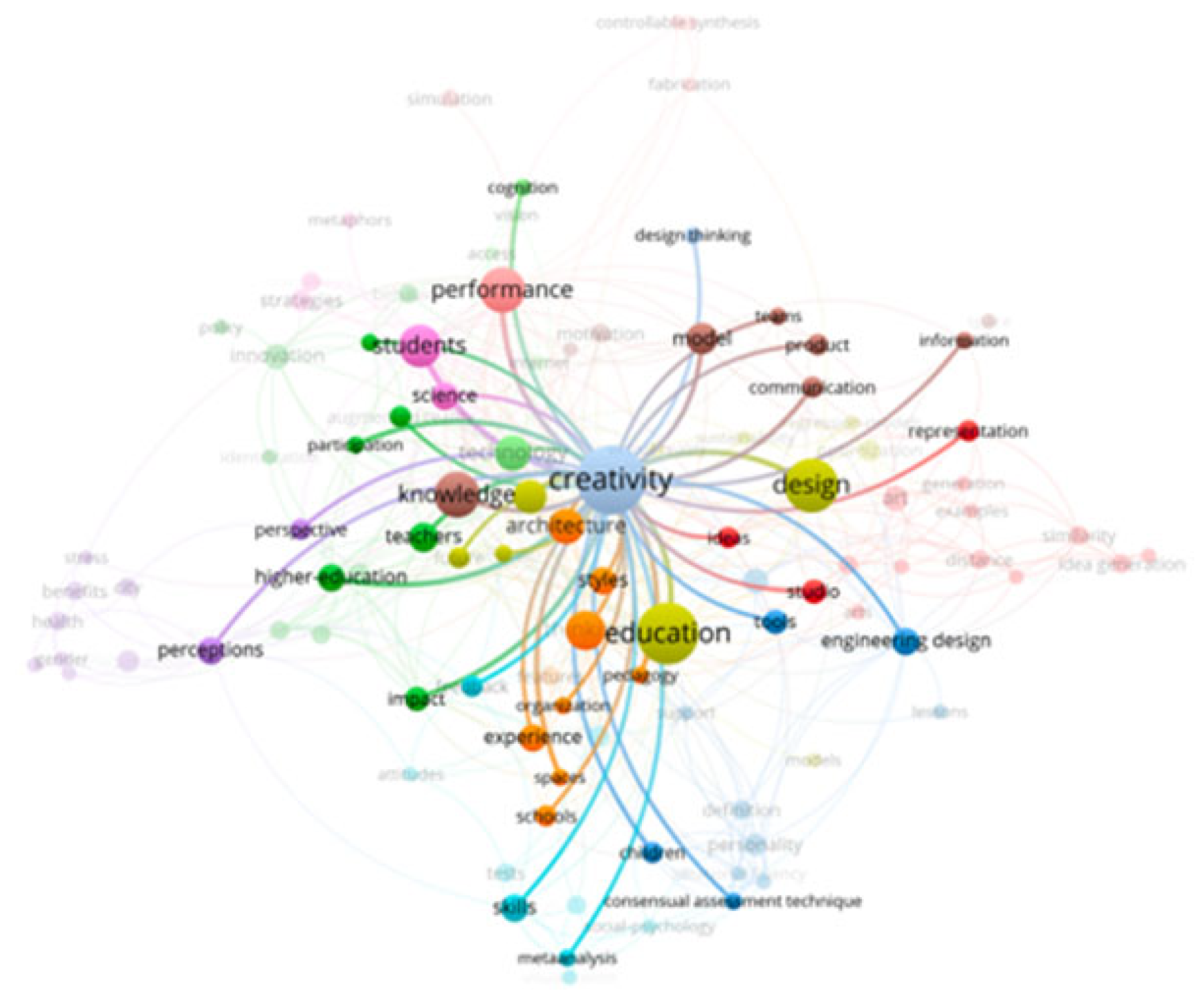 | 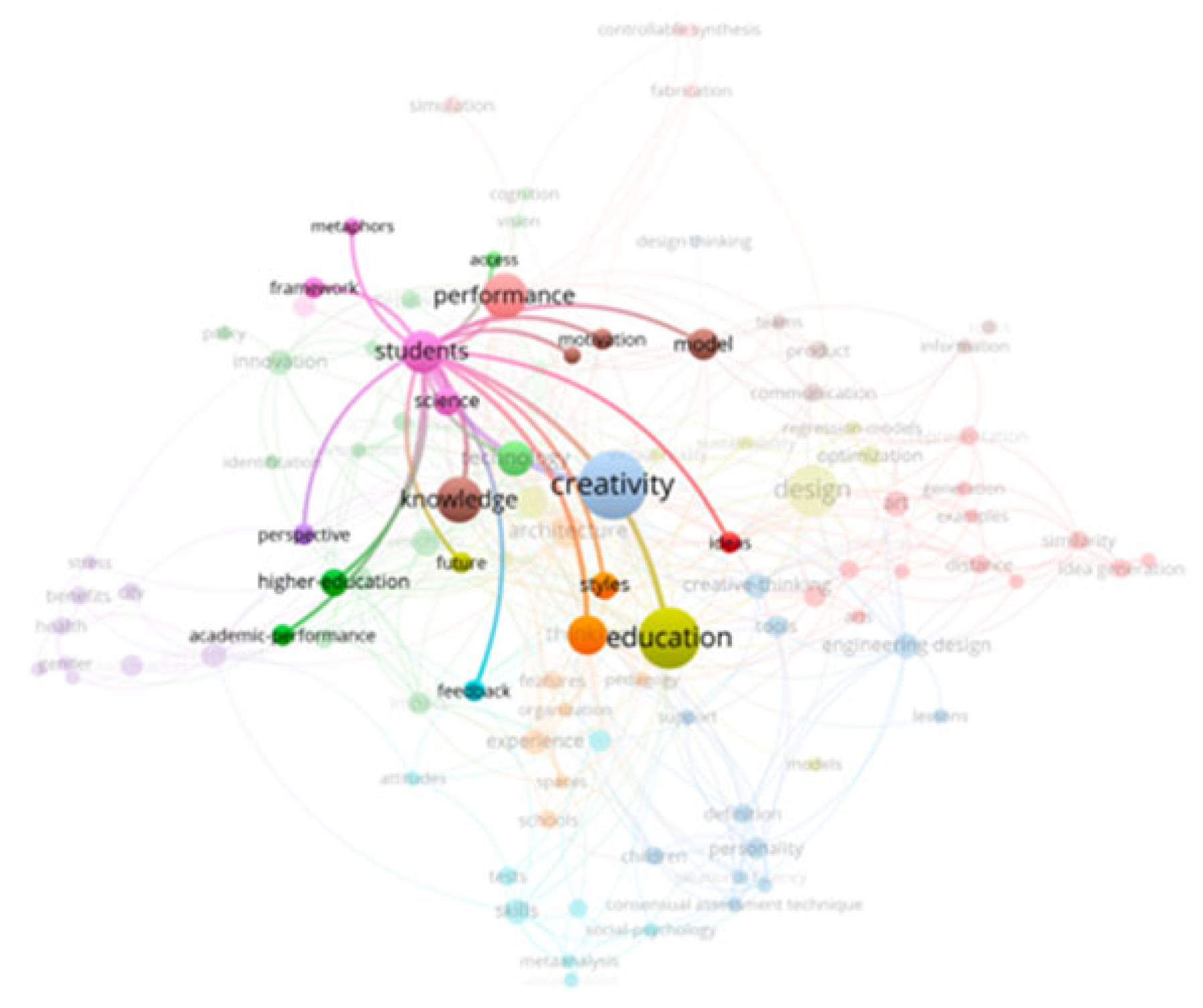 |  |
 |  |  |
| Creativity criteria, Creativity evaluation | Idea generation, Idea development | Pedagogy |
| Themes | Categories | Subcategories | Description | Articles |
|---|---|---|---|---|
| Creativity | Creative criteria | Divergent thinking |
| [5] |
| Convergent thinking |
| [16] | ||
| Abductive reasoning |
| [12] | ||
| Typologies |
| [52] | ||
| [53] | |||
| [54] | |||
| Engineering activity |
| [55] | ||
| Creativity evaluation | Self-evaluation |
| [58] | |
| Metacognitive process |
| [59] | ||
| Structuring architectural processes |
| [60] | ||
| Third elements |
| [61] | ||
| Metaphorical typologies |
| [62] | ||
| Idea generation and development | Reasoning pattern | Analogical reasoning |
| [63,64] |
| [12] | |||
| [65] | |||
| Metaphorical reasoning |
| [27] | ||
| [66] | |||
| Representation tools | Brainstorming |
| [71,72] | |
| [73] | |||
| Drawings |
| [74] | ||
| [75] | |||
| [29] | |||
| Pedagogy | Design studio set-up | Demonstrate |
| [40] |
| Comparativity |
| [58] | ||
| [76] | |||
| Interview |
| [49] | ||
| Historical theory |
| [62] | ||
| Structuring the design process |
| [77] | ||
| Metacognitive process |
| [78] | ||
| [79] | |||
| Enhancing creativity | Self-reflection |
| [80] | |
| Super-cognitive development |
| [59] | ||
| Active exposure |
| [81] | ||
| Problem-solving |
| [82] | ||
| [83] | |||
| [84] | |||
Publisher’s Note: MDPI stays neutral with regard to jurisdictional claims in published maps and institutional affiliations. |
© 2022 by the authors. Licensee MDPI, Basel, Switzerland. This article is an open access article distributed under the terms and conditions of the Creative Commons Attribution (CC BY) license (https://creativecommons.org/licenses/by/4.0/).
Share and Cite
Park, E.J.; Lee, S. Creative Thinking in the Architecture Design Studio: Bibliometric Analysis and Literature Review. Buildings 2022, 12, 828. https://doi.org/10.3390/buildings12060828
Park EJ, Lee S. Creative Thinking in the Architecture Design Studio: Bibliometric Analysis and Literature Review. Buildings. 2022; 12(6):828. https://doi.org/10.3390/buildings12060828
Chicago/Turabian StylePark, Eun Joo, and Sanghee Lee. 2022. "Creative Thinking in the Architecture Design Studio: Bibliometric Analysis and Literature Review" Buildings 12, no. 6: 828. https://doi.org/10.3390/buildings12060828
APA StylePark, E. J., & Lee, S. (2022). Creative Thinking in the Architecture Design Studio: Bibliometric Analysis and Literature Review. Buildings, 12(6), 828. https://doi.org/10.3390/buildings12060828







